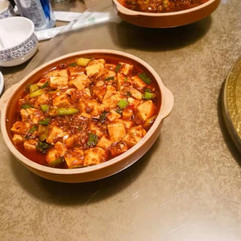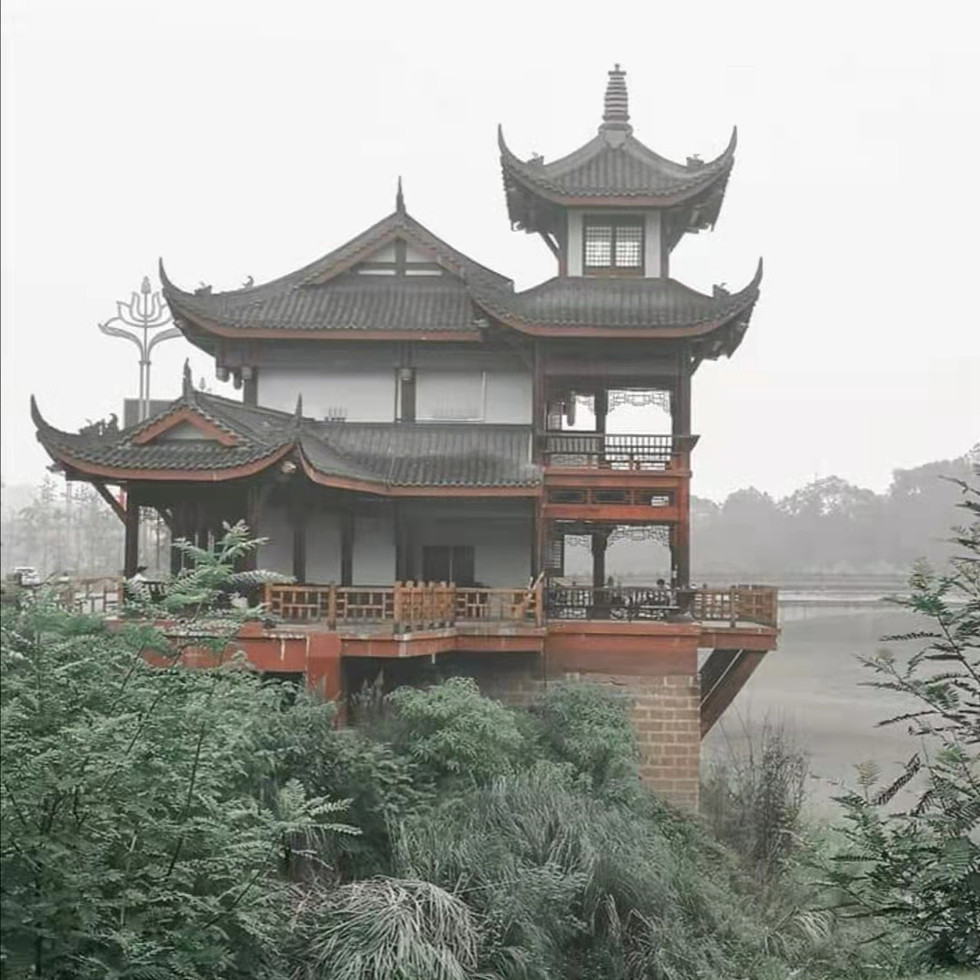Spicy Sichuan
- missltoner
- Feb 27, 2022
- 9 min read
Updated: Dec 16, 2022
In the heart of South China, you'll find the province of Sichuan.
Known for it's Spicy Hotpot and Pandas, it is a must visit province. Sichuan's capital, Chengdu, hosts a rich food scene, and a modern lifestyle. Moving further outwards, you'll find magnificent mountains and traditional elements.
We visited Chengdu straight after school broke up for summer. This meant a sweaty, humid trip with hair that never stayed in style, and outfits that hoped to feel air conditioning.
Our Itinerary
Day 1: Day 2:
Arrive in Chengdu Train to Le Shan
Hospital visit for tests Visit Giant Buddha, Buddhist lunch
Food Tour with Lost Plate Train back to Chengdu
Day 3: Day 4:
Volunteer with Giant Pandas Kuanzhai alleys
Sichuan Hotpot dinner Night out in Chengdu
Day 5:
Street snacks
Travel home to Beijing
Day 1:
Our arrival in Chengdu was very straightforward. We travelled during a 'Low' covid status for each province. This meant, we did not need a covid test to travel, and no requirements aside from a mask were needed. The flight was at a relatively full capacity with no distancing needed. The flight from Beijing PEK to Chengdu took 3.5 hours. Easy to fill time when you've pre downloaded a show as the flight may not have any movies to show.

We stayed at the Sheraton Chengdu Lido Hotel. It was in a good location and was a good price. We opted for the Executive Twin rooms allowing us access to the Executive lounge- this allowed us to save on breakfast, snacks, dinner if needed, and alcoholic beverages. Quality of food and drink was really good. We were located 2 minutes from the nearest subway station, and a 10 minute walk to the nearest mall (pictured right) which also included a vegan restaurant (one of our party is vegan so this was needed, also helpful for others- the food at the vegan place was really good!).
After exploring the area, we caught a didi to the hospital to get covid and blood tests done to be permitted to volunteer with the Giant Pandas. We booked via an agent so we had a Chinese/English speaker to help ease the process. I would highly recommend using an agent provided by the tour for the hospital visit as it was not the easiest process as we were from a different province. Also, they will try to convince you to join their different schemes- do not fall for it- it is not a requirement to get the tests and results).
The Lost Plate food tour on the first evening was a definite highlight. I would highly recommend. Lost Plate offer food tours across different cities across China as well as Cambodia and Portland (USA). With so many cities, English speaking guides, road beers, and tuktuk travel between locations, we were sold. We asked the dietary requirements of the tour, they do cater for vegetarian, but not vegan.
Lost Plate set up a perfect combination of street food, Chengdu delicacies, and sit down restaurant dishes.
We chowed down on street food of stuffed pancakes. We tried 2 different flavours; sweet with sesame paste, and mala spicy. The spicy ones were not as spicy as we thought they would be considering Sichuan is known for it's heat! (Pictured Below Top 1-3)
We tuktuked to the next stop which was for Chengdu style wontons. A family apartment turned restaurant. With 4 types of wonton to try, all filled with pork but in a variety of broth/ oil/ sauce. (Pictured Below Top 4)
The third stop was for dandan noodles. 4 types of noodle were served. Sweet sugar noodles and with peanut sauce were my favourite. They were very different to the usual savoury noodles that you become accustomed to. (Pictured Below Middle 1)
Fourth was to a bamboo entranced restaurant where we munched through braised fish eggplant, mapo tofu (traditional spicy tofu dish), sticky pork rice, gongbao chicken (aka kung pao chicken), garlic ribs. (Pictured Below Middle 2-4, Bottom 1,2)
Lastly, after an effort the Hungry Caterpillar would be proud of, we finished at a baijiu bar for plum spirits. The bar was situated on the Jin River so was a great location to finish an amazing culinary experience. (Pictured Below Bottom 3)
Day 2:
After eating our way around Chengdu the night before, we travelled to Le Shan to walk off the extra calories consumed!
Our trip to Le Shan was not simple! We chose to not buy train tickets in advance as it is only a short trip from Chengdu. BIG MISTAKE! We had to wait 2 hours in the train station to buy train tickets. We bought return while there to save the hassle for the way back.
GET YOUR TICKETS IN ADVANCE! I would recommend business class; for only a fraction difference you get a more comfortable seat, a snack pack and water for your journey.
When you arrive in Le Shan, you'll be greeted by many drivers offering you a trip to Giant Grand Buddha. Do not do this. Didi/ Taxi to the entrance which is easiest and cheaper!
We entered the scenic site entrance so we could climb to the Buddha. Be aware you will need to pay twice if entering this way. Once for the hike, once for the Buddha. I would recommend bringing a fan if possible as it is a HOT walk! I ended up buying one whilst there, a more expensive option- but I figured I can use it as a great souvenir.
When entering the UNESCO World Heritage site for Giant Buddha, expect a long wait. The pathways are very narrow so only a set amount of tourists can walk to the Buddha each time. You can start at head level, then follow a pathway down to the feet of the Buddha. The path back up to the head level is very steep (see pictures below). This trip is not advised for those who have disabilities that require slopes rather than stairs.
He is very breath taking, with fingernails larger than a person, he is the world's largest ancient Buddha at 1200 years old. Also, he is spotted in the movie "Abominable" which follows a little girl trying to take a Yeti back home to Everest.
Giant Grand Buddha in numbers:
-1200 years old -71m tall -28m width -8.5m long toes
Whilst in the park, there are one or two options for eating at the top. We choose the Buddhist cafe. You pay a small fee for vegan food and can buy soft drinks to accompany.
We managed to miss a downpour, but felt the wrath afterwards. The stones that are used as steps get really slippery. We all nearly fell many times even though we were in sensible footwear! Definitely a must see when in Sichuan.
After a long day, we had the test results delivered to our hotel, ready for the volunteering with the Giant Pandas, which we scrutinised over dinner at the hotel's Executive lounge.
Day 3:
The morning after a busy day hiking and travelling, we were picked up early to visit the mascot of China- the Giant Panda. We booked to volunteer through a tour company to help ease the process (especially for during times of Covid) which admittedly was more expensive, but meant our travel and experience was eased dramatically! We visited the China Conservation and Research Centre for the Giant Panda (aka Chengdu Panda Base). This research centre opened in 1987 and is responsible for breeding the largest amount of captive Giant Pandas across the globe. However, one of the most amazing aspects of this base is that they train pandas to be released back into the wild rather than trying to keep pandas in captivity.
Our experience lasted 8 hours. We were introduced to our leader for the day, given our t-shirt and all access lanyard to wear, and set to work. Firstly, helping clean the panda homes. These are where pandas go to be fed, washed, weighed etc.
We then were given a guided tour of the park, introduced to different holding areas for the pandas, and educated about the project as well as each panda's history. We were permitted to explore the park further in our 'free time' after we had finished feeding them and ourselves. After the initial feeding, it was time for our lunch. We ate at the staff cafeteria, with the other workers.
Following our lunch we visited the gift shop (obviously), grabbed an ice cream and a drink to counter the Sichuan Summer heat and explore the reserve. The park is closed at lunch time so it was great to see the pandas sleeping after their meals.
Later on, we were to feed the pandas again, but not before an educational film about the Panda research base. Watching how the base was rebuilt after a natural disaster was very harrowing. The final feed of the day, allowed us to feed an older Giant Panda. It was surreal being so close to this strong, gentle bear. Before leaving we had one more cleaning duty, then it was time to make 'panda cake'. This treat allows older pandas to get the nutrients they need in a softer format than bamboo. Using bamboo shoots, beans and other items to create a mushy textured 'dough' before it's rolled into shape and steamed.
At the end of the visit, we were awarded our panda husbandry certificates for our contribution towards the conservation of the Giant Panda.
It was honestly an unforgettable experience that I will treasure. I highly recommend paying extra to take part in volunteering rather than just visiting the park.
Following on from an exciting and exhausting day of "hard graft" (count at least 20,000 steps), we popped around the corner from our hotel to one of the well known Hotpot restaurants. Spicy Sichuan Hotpot is a famous dish to try when in the province.
We rocked up, pulled our ticket, and sat on mini stools in the humidity for 2 hours while waiting for our table. Sporadic trips were taken to the nearest 7/11 to pick up Rio alco-pops, hair ties, and beers to fuel our wait.
Our number was called and we entered the most beautiful, traditionally adorned hotpot restaurant I've set foot in. With beautiful wooden decor matched with red lanterns, it was the perfect setting for hotpot. Sitting at a wooden table next to open wooden shutters, we ordered a spicy hotpot broth with a mushroom broth section, as well as an array of items to boil in the angry numbing broth. An experience to be had when in Sichuan... especially if you manage to survive the insane numbing spice.
Day 4:
After 2 long, exhaustive days, we chose a relaxed morning wandering around the Chengdu equivalent of the hutongs- Kuanzhai alleys. These traditional alleys harbour a creative vibe with coffee shops (including the prettiest Starbucks), tea houses, and traditional make up parlours. Dotted in between are boutiques, art stalls, and street food vendors. Kuanzhai alleys were my favourite part of Chengdu. The laidback feel and graffitied walls made for a chilled stroll to escape the modernity and revisit the ancestral. Before leaving the alleys, I found an amazing artist's booth. He had created a hand drawn colouring book of all the sites in Chengdu- a wonderful book of memories.
After a morning of meandering the hectic alleys, we made our way back to the hotel for some rest and to change ready for a meal in the revolving restaurant at the top of the tallest tower in Chengdu (Chengdu West Pearl Tower)... However, we couldn't find ANY information online, the concierge had no contact information, so... we risked it. Turned up at the tower without a reservation. BUT- IT WAS CLOSED! The tower stops allowing new visitors 30-45 minutes before it closes. It closes at 21:30. This means we were too late to go up the tower.
PLEASE USE THIS AS A WARNING- Arrive early doors at the tower if you want a chance to eat there and/or manage to see the city from 339m.

Instead of eating at this beautiful 339m tall restaurant, we found a bar called Commune not far from the tower, so we parked ourselves in our "nice outfits" at a high table, ordered snacks and drinks, and played games until the early hours before trying to find some late night street food. A fun night to celebrate our time in Chengdu coming to an end.
Day 5:
Our final day saw us heading back to Kuanzhai alleys for others in our party to buy a book from the artist we had found the day before. We got out hands on some spicy potato spiral snacks and some fruit tea before heading back, grabbing out luggage and heading to the airport for our flight back to Beijing.
Sichuan province has so many aspects of China, that tourists expect to see. It blends the traditional and modern perfectly. Another aspect that is great for tourism, is that travelling around the city of Chengdu and its neighbours is so cheap! From taxi, to food. The cost is a fraction of what you usually pay for the same items in Beijing.
All views and images are my own
This trip was self funded, is not an advert
Lost Plate reached out to collaborate AFTER my trip to Chengdu.
This article is not influenced by Lost Plate.
To book a place on a Lost Plate Tour and receive discount, use the code: PROSECCOSUNGLASSES
Copyright Lauren Toner 2019-2022









































































Comments